Index

Review: AMD strikes back with a vengeance
Today is Radeon HD 6900 day and AMD has a lot riding on the new Cayman series. As usual, the new series offers two cards dubbed Radeon HD 6970 and Radeon HD 6950. Both are based on the new Cayman core, AMD's second generation DirectX 11 core. Of course, unless you spent the past six months under a rock, you probably knew this, but now that the intro is out of the way, we can get on with stuff that actually matters.
Radeon HD 6970 will succeed the HD 5870 on AMD's single-GPU throne and it will compete against Nvidia's Gefroce GTX 570. The fastest single-GPU card in this year will still be the GTX 580, but the fastest card around overall remains the one-year old AMD dual-GPU HD 5970.
Since both graphics heavyweights are well behind their deadlines, the fight for the fastest graphics card is expected to start in early 2011. This period will see AMD announce its dual-GPU HD 6990, whereas Nvidia will be ready with its own dual-GPU board.
This year seems to have favored AMD when it comes to DirectX11 cards, as the company managed to fill out its DirectX11 lineup quite nicely and much sooner than Nvidia. AMD's execution was nothing short flawless, which can't be said of Nvidia. Furthermore, sales figures confirm that AMD won this round with about 25 million shipped DirectX11 cards under its belt.
However, as much as AMD and Nvidia try to promote new DirectX 11 technologies, Steam statistics say that 85% of gamers still didn’t upgrade to DirectX 11. The reason is more or less the lack of DirectX 11 games. With its HD 6900 series, AMD aims at hardcore gamers looking for top performance and plan to upgrade to DirectX 11 graphics with a brand new graphics card.
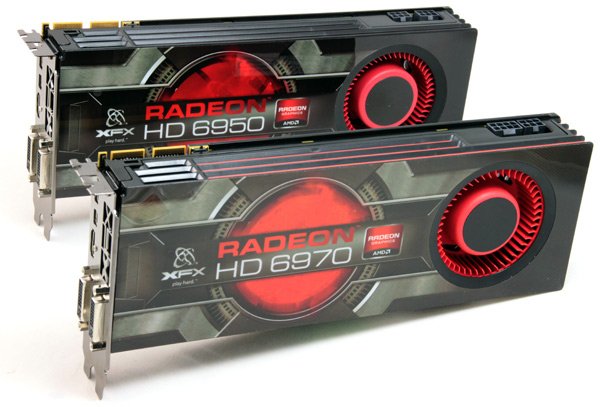
The Cayman Architecture 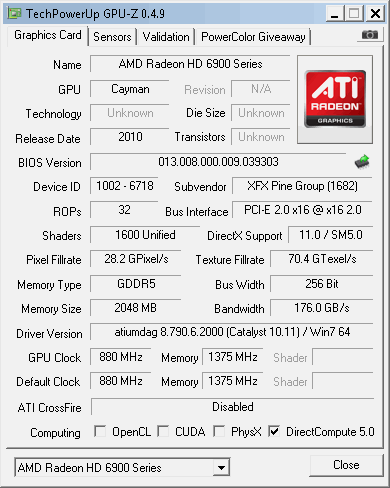
Radeon HD 6970 ; Driver: HD6900_8.79.6.2rc2_Win_Vista_7
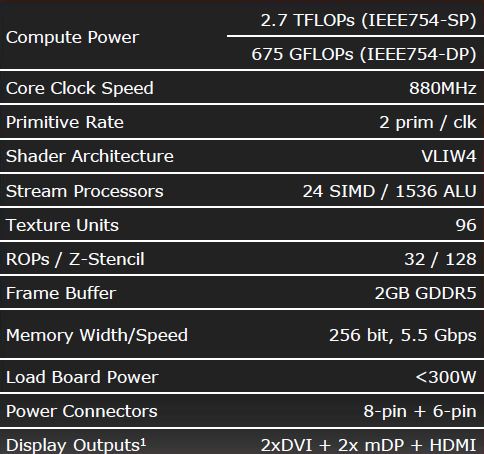

Radeon HD 6950 ; Driver: HD6900_8.79.6.2rc2_Win_Vista_7
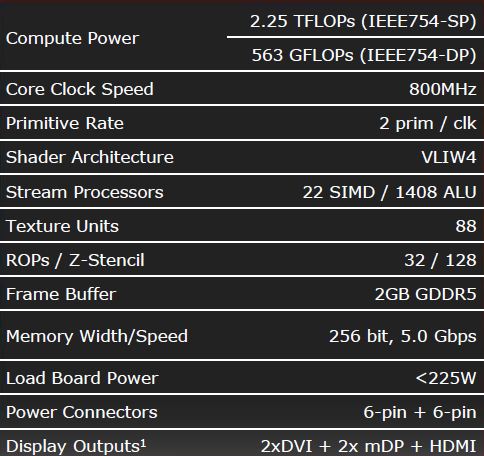
The recently released AMD Barts GPU used the “old“ VLIW5 design, although it had some neat features regarding the actual design of the chip (individual dispatch processors for each of the SIMD blocks). Cayman on the other hand feels like real evolution as it indeed features the new VLIW4 design. This means that it has four proper stream processing units, as opposed to VLIW5 with four simple and one complex SP unit.
Cayman now uses what AMD calls a 4-way co-issue. This means that all stream processing units have equal capabilities, and there is no complex SP unit (also known as the T-unit).
The new VLIW4 design should provide a ten percent improvement in performance per mm2, at least according to AMD. Although it looks like all four SM units are equal in size and use, it appears that two (third and fourth) are assigned with some special functions, also known as the transcendentals. Bear in mind that they have nothing to do with Walt Whitman and Ralph Waldo Emerson.
The talk of greater parallelization started with the Barts GPU which had individual dispatch processors for each SIMD Engine Block, something that certainly helped Barts with tessellation. Cayman on the other hand, has two graphics processing engines (GPEs), one for each SIMD engine, which means that it should raise the tessellation performance by a factor of three to four when compared to the HD 5870, at least on paper.
Another novelty is the upgraded Render Back-End which in Cayman's case has 128 Z/Stencil ROPs, 32 color ROPs, 2x faster 16-bit integer ops and 2-4x faster 32-bit FP ops.
XFX's HD 6970 is a reference design card measuring 27.4cm in length, just like the HD 6950 (the PCB measures 26.5cm). The cooling is also the reference solution and the cooler looks similar to the one employed on HD 6800 cards. However, unlike HD 6800 boards, the HD 6900 series features a backplate, much like HD 5800/5900 series cards.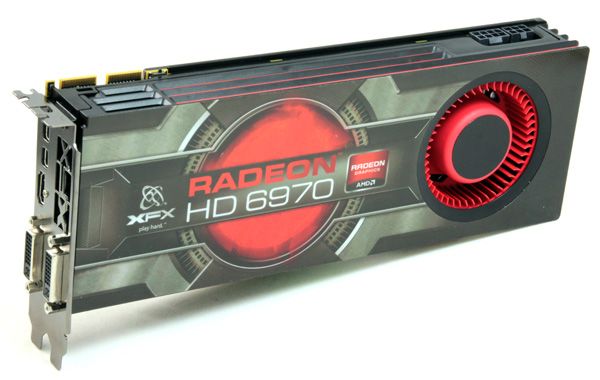
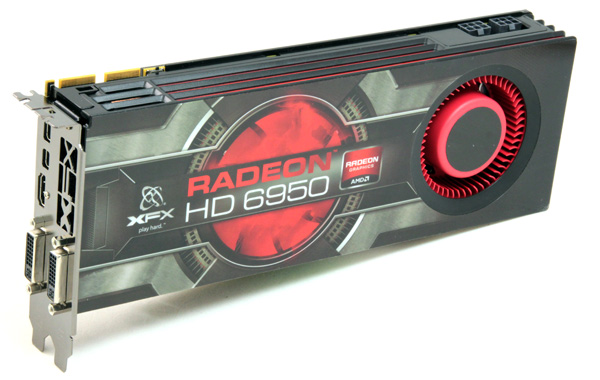
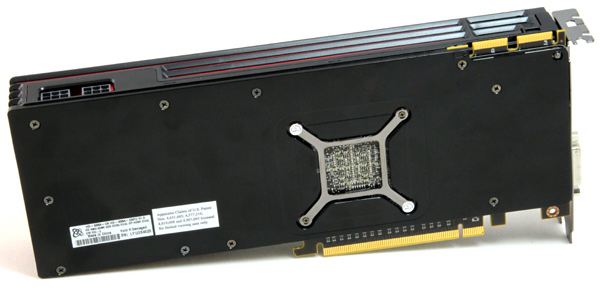
The I/O panel features two DisplayPort 1.2 connectors, HDMI 1.4a and two DVI connectors (one of them is single-link with a maximum resolution of 1920x1200). By using DisplayPort outputs it’s possible to chain up to six monitors to a single card. As far as sound goes, HDMI 1.4a provides Dolby True HD, DTS-HD, AC-3, DTS and up to 7.1 channel audio with 192KHz/24bit output.
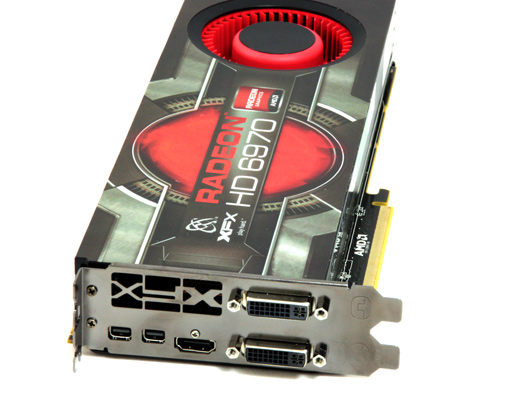
Like its HD 6970 brother, the HD 6950 also sports a XFX-branded exhaust vent. XFX Radeon HD 6950 features two DVIs, one HDMI and one DisplayPort.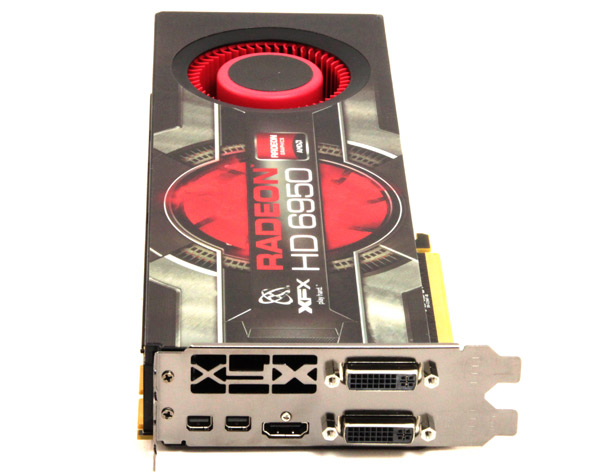
Unlike the HD 6800, HD 6900 comes with two CrossFire connectors. This means that you can use four cards in a 4-way CrossFire.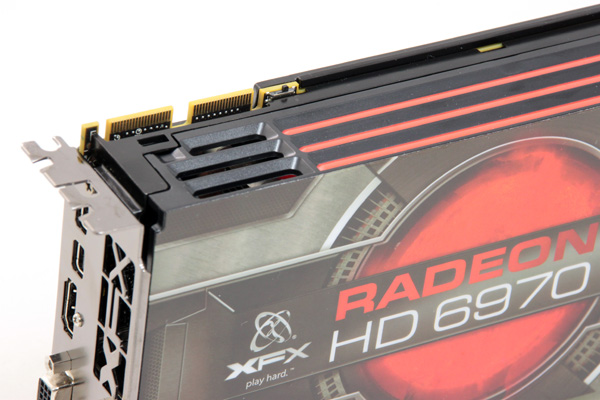
The card also features a dual-bios toggle switch that makes bios updates a breeze. Setting 1 is unprotected for user updates, while setting 2 is the protected factory default mode. Clever.
The TDP, something that has been quite a debatable topic recently, is set at 200W for the HD 6950. AMD is currently using three different TDP values and calls them PowerTune Maximum Power, Typical Gaming Power and, of course, Typical Idle Power.
Note that 200W is AMD's PowerTune maximum power whereas typical gaming power is set at 140W. Idle TDP is set at 20W, same as the HD 6970. The card needs two 6-pin PCI-Express power connectors.
The PowerTune feature looks similar to a gimmick used by Nvidia on its GTX 580 card and it looks like this one locks the HD 6970 maximum TDP at 250W. Typical Gaming Power is set at 190W while the idle stands at 20W.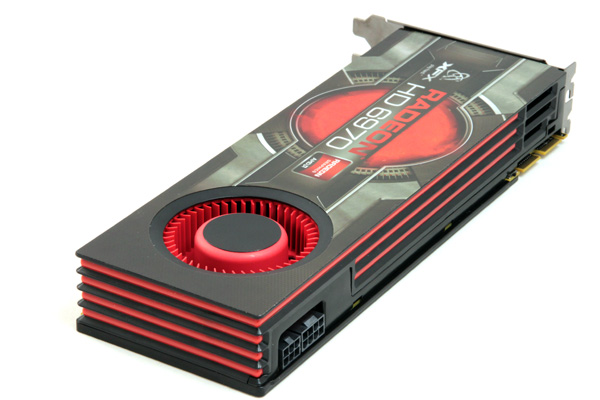
XFX used its standard box design for the new Caymans.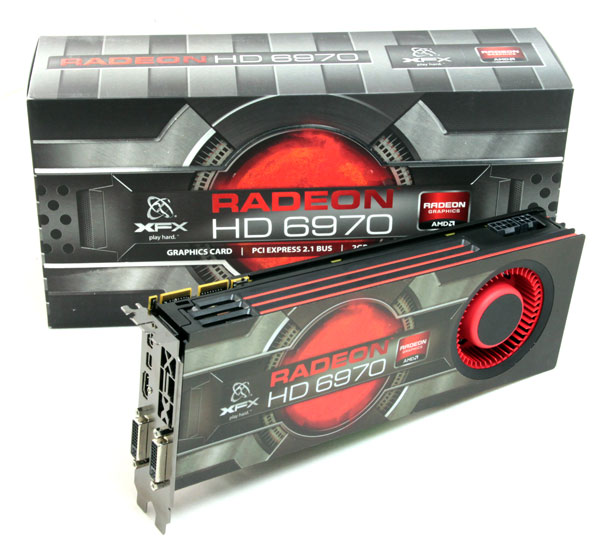

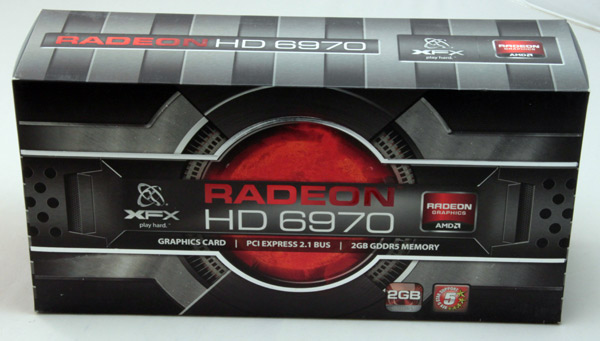
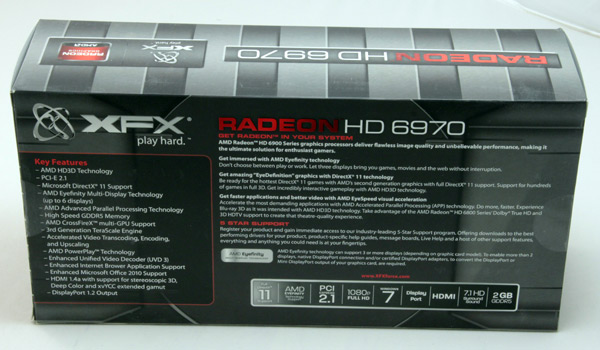
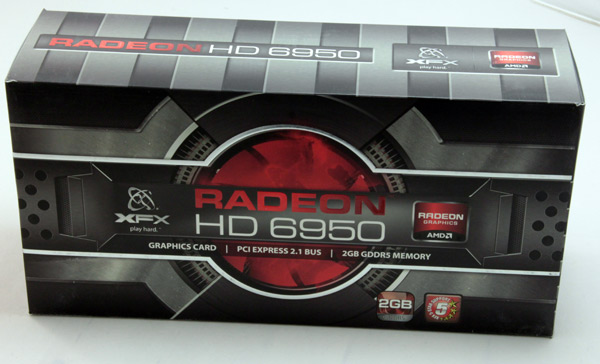
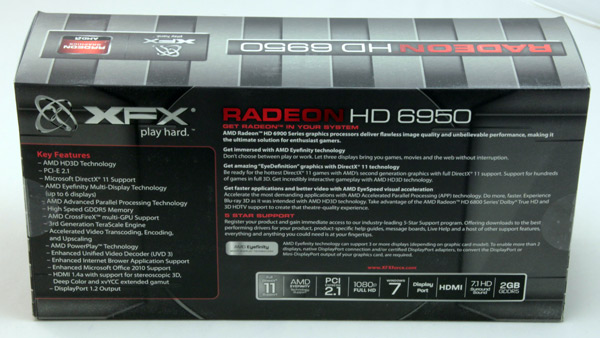
Testbed
Motherboard: EVGA 4xSLI
CPU: Core i7 965 XE (Intel EIST and Vdrop enabled)
Memory: 6GB Corsair Dominator 12800 7-7-7-24
Harddisk: OCZ Vertex 2 100 GB
Power Supply: CoolerMaster Silent Pro Gold 800W
Case: CoolerMaster HAF X
Fan Controler: Kaze Master Pro 5.25"
Operating System: Win7 64-bit
263.09_desktop_win7_winvista_64bit
HD6900_8.79.6.2rc2_Win_Vista_7
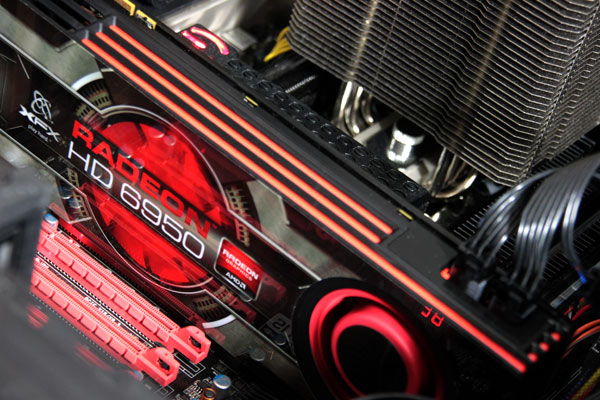
3Dmark 2011
In 3Dmark 2011 Radeon HD 6970 scores slightly lower than 8000 at entry settings while the GTX 580 scores 8700 in the same test. The runner up, Nvidia's GTX 570, scores slightly above 8000 while the GTX 480 is slightly below 8000.
At performance settings Radeon HD 6970 a.k.a. Cayman XT scores around 5300 while the GTX 580 scores are just tad below 6000 and the GTX 570 loses by an inch with 5251. GTX 480 scores are almost identical to the GTX 570, its 5244 points are again slightly lower than the HD 6970.
In more extreme conditions Radeon HD 6970 scores 1744 while the GTX 580 scores 1963. Radeon HD 6970 again wins against the GTX 570 and GTX 480, which scored around 1680.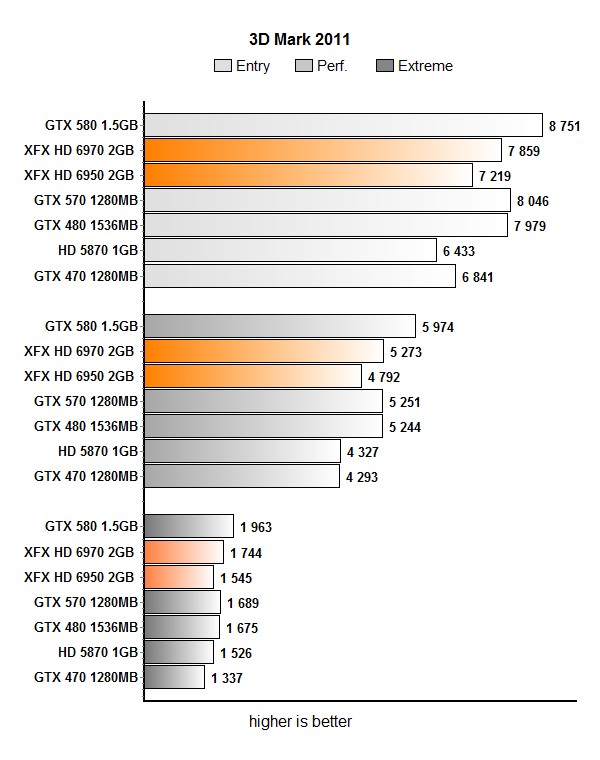
3DMark Vantage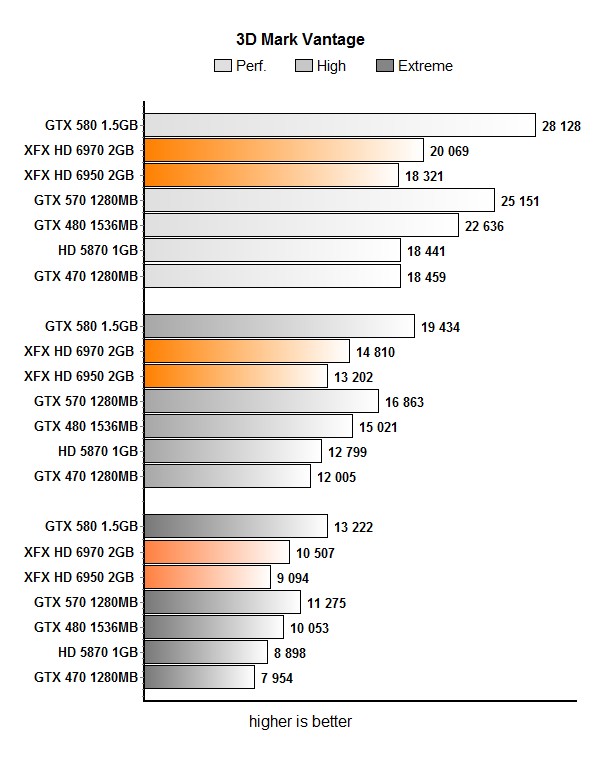
Games: Aliens vs Predator
AMD has improved Antialiasing performance on the HD 6900 series and this is clearly visible in AvP tests. The HD 6950 is faster than the Cypress-based HD HD 5870 with maxed out antialiasing.
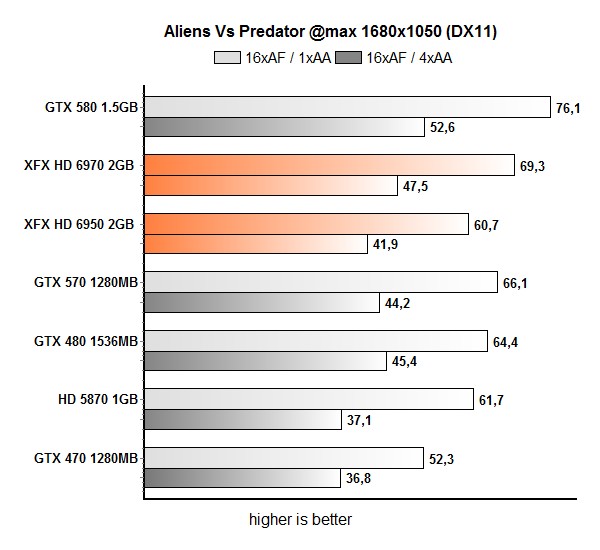
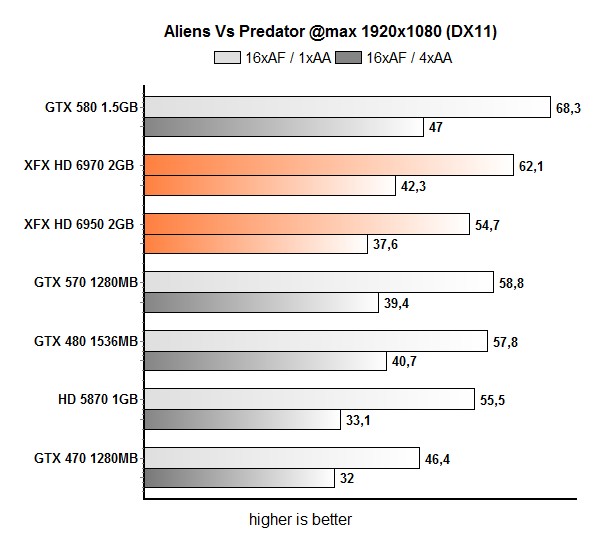
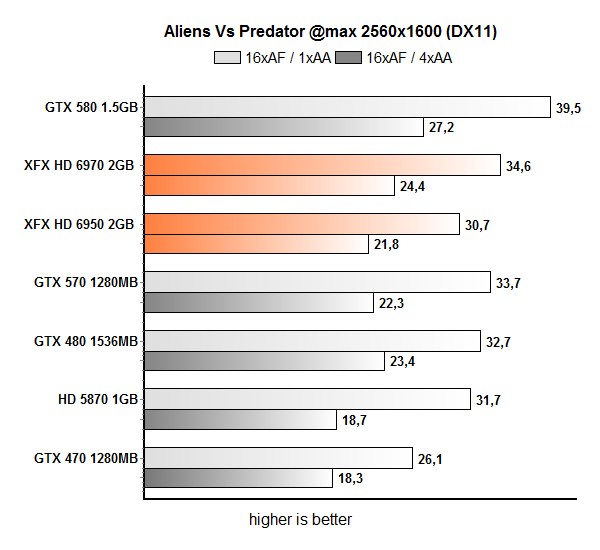
Games: Dirt 2
In Dirt 2 the HD 6950 matches or outperforms the HD 5870. The HD 6970 can't keep up with the GTX 570 in this particular game test, but still we see impressive performance on all resolutions.
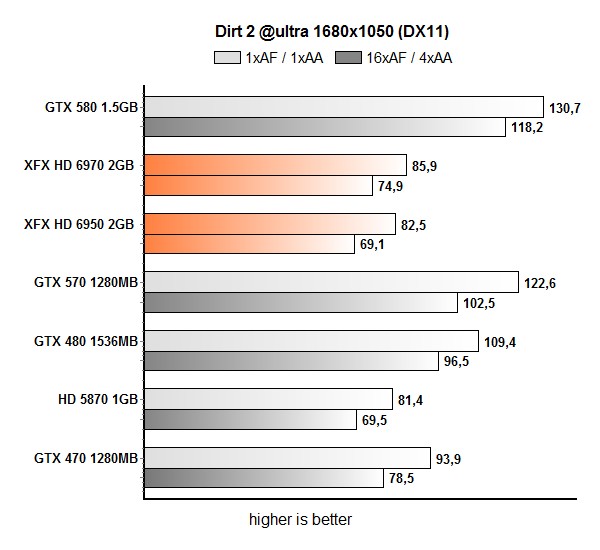
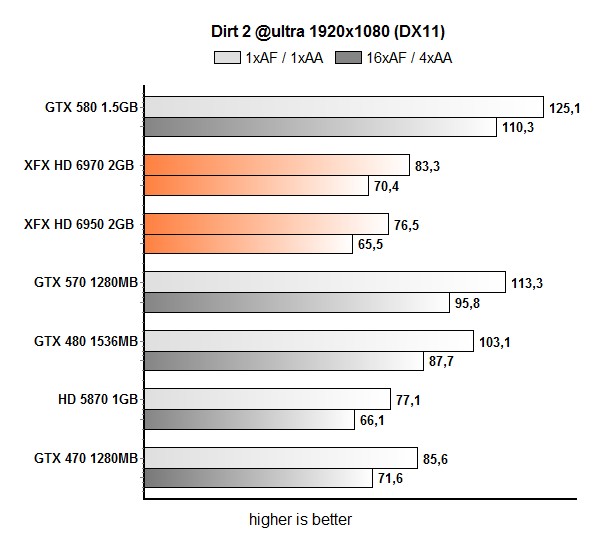
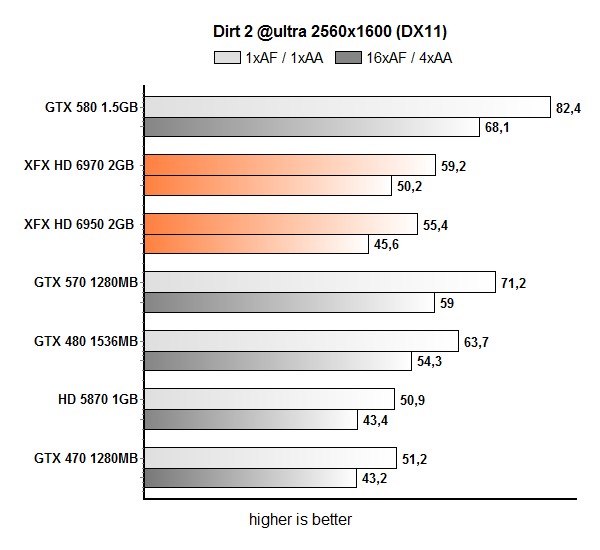
Games: Metro 2033
In Metro 2033 we can clearly see that AMD has managed to improve tessellation performance on the new Cayman generation. The old HD 5870 loses by a wide margin, but Nvidia's GTX 570 still manages to outperform the new Cayman boards.
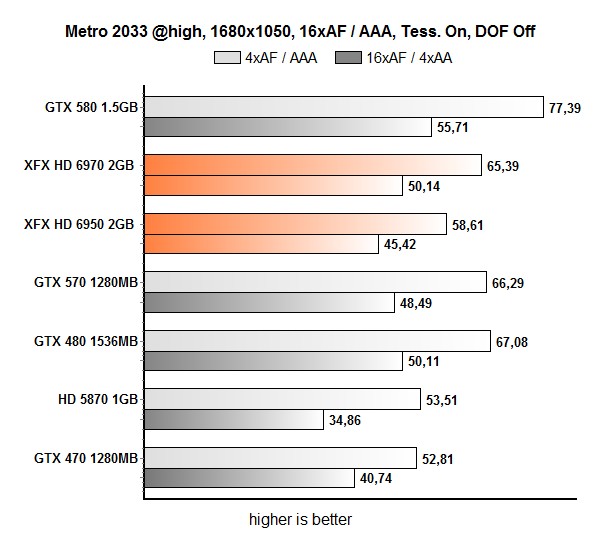
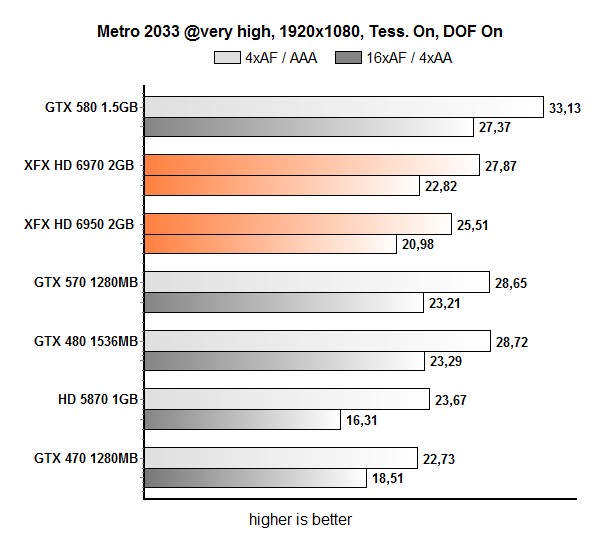
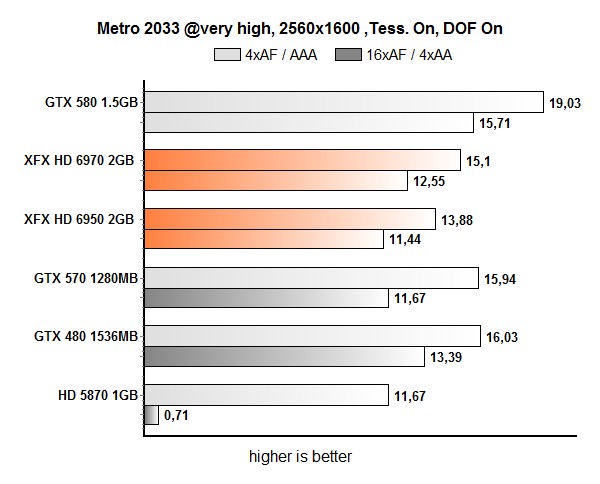
Tessellation: Unigine Heaven
In Unigine, AMD's efforts to boost tessellation performance bear fruit once again. Nvidia cards manage to outperform the new Radeons in Extreme tests, but this is hardly a real-world benchmark. Using more realistic Normal settings, AMD can easily stand up to Nvidia, which means it has managed to close the tessellation gap and meet Nvidia's tessellation performance. Although some might consider this fact to be somewhat trivial considering tessellation support in current titles, it's worth noting that superior tessellation performance was one of Nvidia's main selling points over the past few months.
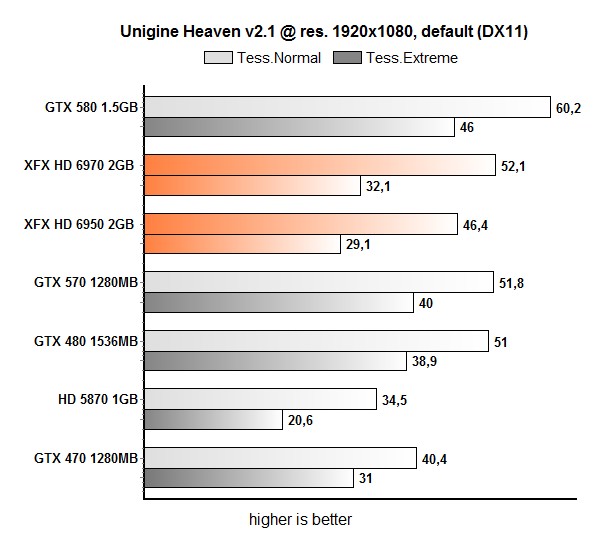
Tessellation: TessMark
TessMark tests resulted in rather horrid results for Cayman cards, but this is clearly a software issue related to older Catalyst releases and it should not be taken seriously. AMD claims TessMark performance will be vastly improved in new driver updates, scheduled for early 2011. Despite this, we chose to include the results in our review, just to annoy fanatic fanboys who have already issued several fatwas calling four our untimely deaths.

Overclocking HD 6970
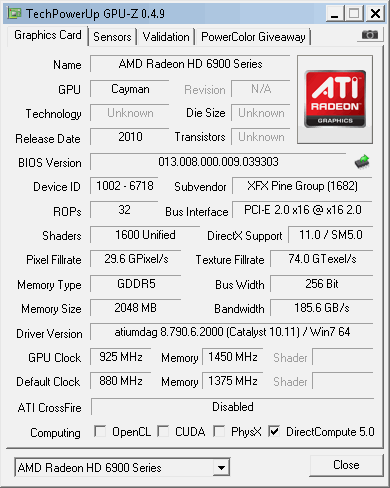
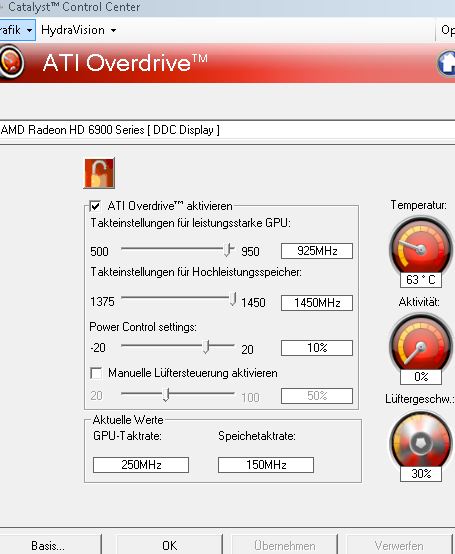
Overclocking HD 6950
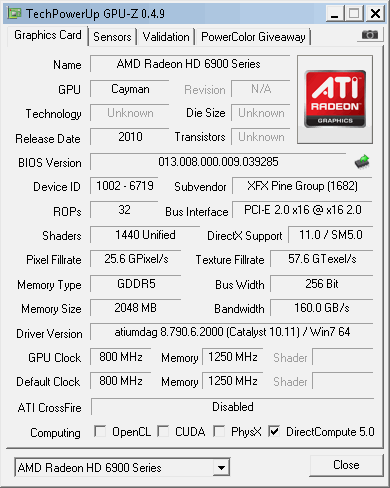
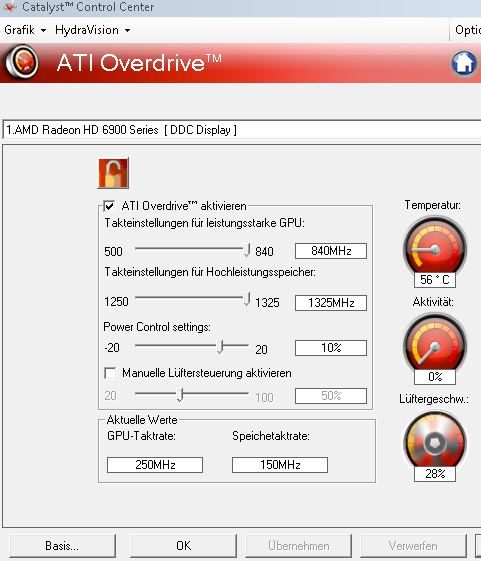
Overclocking Score
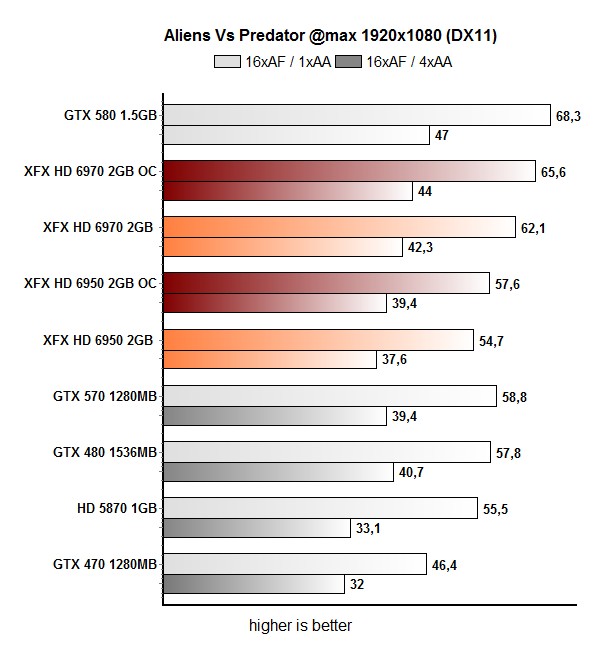
AMD PowerTune
A simple explanation of AMD’s PowerTune technology is that the GPU runs at maximum clock until it detects potential problems with thermal dissipation; the latter scenario causes the card to downclock. The nominal GPU value is 880MHz, and the GPU should run within its TDP „budget“.
AMD implemented several low-frequency states so that PowerTune technology can dynamically alter clocks based on the internal calculations of the GPU’s power consumption. A similar technology is found in Nvidia's GTX 570 cards, where dynamic altering of clocks effectively manipulates TDP without affecting performance. GTX 580 is the first card to implement such hardware monitoring technology and AMD's new cards also rely on it. However, when compared to GTX 570 or HD 6900, the GTX 580’s engine seems simplified as it downclocks the GPU by 50% upon detecting FurMark and similar apps, and that’s that. Basically the GTX 580 proves that muscles don't usually mix with brains.
This technology is a rather nice feature if you're dealing with a smooth running game, as it will allow you to conserve energy and lower noise by simply sliding the controls in PowerTune. It will also keep the temperatures lower by reducing the clocks and lower temps are always a good idea.

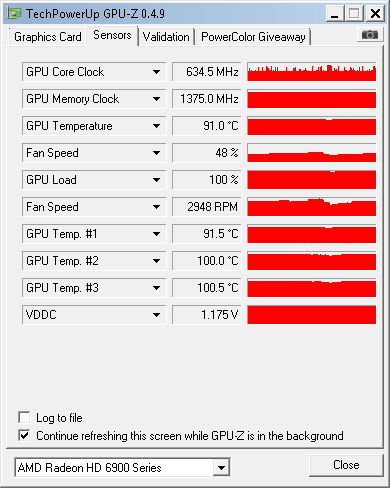
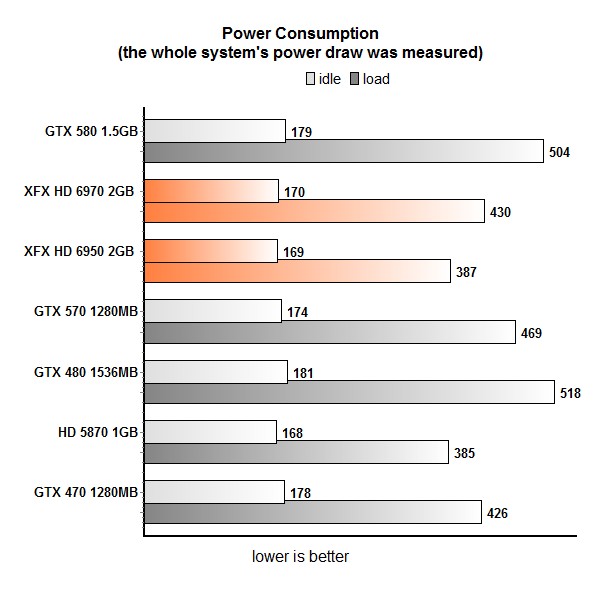
Conclusion (of 2010)
The closing weeks of 2010 have proven to be quite an exciting time in the graphics business. After Nvidia successfully launched the GTX 580, surprising many observers who did not expect such a successful revision of the massive Fermi core, AMD took a somewhat defensive stance after more than a year in the lead.
The HD 6900 series is AMD's response to the new threat and now we know what both teams have to offer on the pitch. AMD took an early lead thanks to its successful HD 5000 series and Nvidia's delays, but in the latter half of the year Nvidia managed to score back some ground with the affordable GF 104 core and the speedy GF 110. Despite this, AMD cashed in on its lead and outsold Nvidia in the DirectX 11 market by a comfortable margin. However, at the end there can be only one true winner and you will be happy to know that it's you, the consumer.
AMD can claim a victory in total sales numbers and the fastest graphics card on the market, thanks to the HD 5970, Nvidia managed to retain the title of fastest GPU on the planet with the GF110. However, the end result of that the struggle is visible in any price search engine. Consumers can choose between several competitive graphics cards in all market segments at relatively modest prices.
The XFX HD 6950 and XFX HD 6970 are excellent products and if you are in the market for a high-performance DirectX 11 card, they are more than a good choice. Compared to Nvidia's GF110 cards, the new Radeons manage to perform admirably. The HD 6970 easily matches the GTX 570 in terms of performance, yet it should cost a bit less, between five and ten percent less. However, the HD 6950 truly manages to hit the sweet spot. With VAT, it's projected to cost between €250 and €275 depending on the market and at the moment Nvidia simply doesn't have a product to counter it. In addition, it's somewhat quieter than the HD 6970. It's faster than the old HD 5870, especially in new games and it has a more advanced architecture with greatly improved tessellation performance.
So there you have it. AMD did not unsettle the GTX 580, but it has done something even better. It has churned out two competitive and very well priced graphics cards that will surely end up on many Christmas shopping lists. Great work, especially in the tessellation department. The GTX 580 is still king of the hill, the HD 6970 ties with the GTX 570 both in terms of price and performance, while the HD 6950 is truly in a class of its own and offers very good value. That's it for 2010 folks, but as soon as we sober up after the holidays, both AMD and Nvidia will spice things up with new dual-GPU cards, just in time to save on heating bills in the northern hemisphere.



